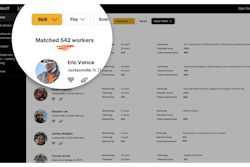
Across the construction industry, businesses are still reckoning with the negative byproducts of manual expense reporting, encompassing policy and control challenges, coding mistakes, lost receipts, and unruly spreadsheets, among other headaches. With so many different projects and billing codes, a manual expense process is fraught with potential errors.
Advances in expense management technology are making many of these challenges easier to navigate by providing greater visibility and control over daily expenses – but many small- to medium-sized businesses remain slow to adopt new software solutions and processes. Approximately a third of SMBs continue to rely on spreadsheet-based expense management and manual reporting, creating laborious submission and reconciliation workflows and lengthy close periods; perennial pain points of employees and finance leaders.
For the project-based construction industry in particular, quickly processing employee expenses is vital to propelling projects forward. Properly accounting for these numerous expenses, ranging from transportation costs to materials and supplies, is essential for maintaining budgetary control, maximizing profits, and ensuring customer satisfaction.
Streamlining expense reporting processes not only frees up time for busy employees and finance teams, it empowers a culture of greater fiscal transparency and results in better decision making. Here’s how embracing digital transformation in expense management can benefit your business and enable both employees in the field and the office to take control of spend and protect the bottom line:
Shifting From Batch-based to a Real-time Mindset
A significant challenge in traditionally batch-based expense management is the delay between expense accrual and finance team visibility, impeding awareness of budget adherence. For construction companies that require clear insight into day-to-day expenditures to effectively oversee and regulate finances for multiple projects, the lack of transparency from this approach can be problematic.
To achieve greater transparency, expenses should seamlessly integrate into an expense management platform as they occur. Employing an integrated card and expense solution can automate the process, granting finance teams and project managers real-time access to spending data. This eliminates the need to await month-end expense reports to take action on budgets or projects that require attention.
Another key element to enabling real-time visibility is simplifying the process for crew members to submit expenses on the go. Rather than spend time parsing through receipts and expense entries at the end of the day or week, employees should be equipped to easily enter expenses throughout the day, while the purchase is top of mind. This reduces the risk of expense entry mistakes and allows employees to focus on their primary responsibilities and spend more time executing, driving the business forward by consistently delivering value to the customer.
Real-time visibility enables workers and finance leaders to keep tabs on expenses as they happen and ensure compliance, empowering both parties with the knowledge of where budgets stand, and giving them the opportunity to take swift action on budget management.
Leveraging Expense Management Innovations
With manual processes, finance teams dedicate considerable time each month to scrutinizing expenses and meticulously reviewing transactions to ensure accurate coding and policy compliance across numerous jobs. Innovations in expense software enable teams to streamline the process, automatically distinguishing which expenses are compliant and which require further review. Artificial intelligence and machine learning capabilities can enhance accuracy by learning from past instances of miscoded expenses.
The benefits of automation are far reaching. It has the power to make expense management processes more straightforward for both employees and finance teams. It can remove the guesswork from compliance with automated guardrails that flag out-of-policy spend in real time, making fiscal control seamless. It cuts down on labor-intensive processes by automatically attaching receipts to corresponding expenses, improving categorization accuracy across projects.
These tools make expense management and policy adherence simpler for everyone, enabling teams to take better control of the expense process and make more knowledgeable decisions on a day-to-day basis.
Empowering Greater Fiscal Control
Greater transparency around the expense management process helps businesses cultivate a culture of better decision making when it comes to managing finances and driving growth.
For employees, ease of expense entry and having a greater awareness of policy and budget adherence enables them to identify trends and opportunities for saving, increase productivity, and practice more informed decision making.
For business leaders and finance teams, harnessing real-time spend data across the company enables them to effectively oversee customers, costs, profit margins, and sales. By fully utilizing this data, construction companies can extract valuable insights and trends, analyzing expenses across various dimensions and at different levels of granularity, from high-level summaries to detailed breakdowns.
Cultivating greater transparency around the expense process for all employees not only empowers stronger financial decision making across the business, it ultimately benefits customers by ensuring projects go smoothly and remain on budget, setting the stage for continued business success.
Niki Patrick is director of accounting at BC Stone Homes and Nicole McCarthy is director of CX at Center.



















